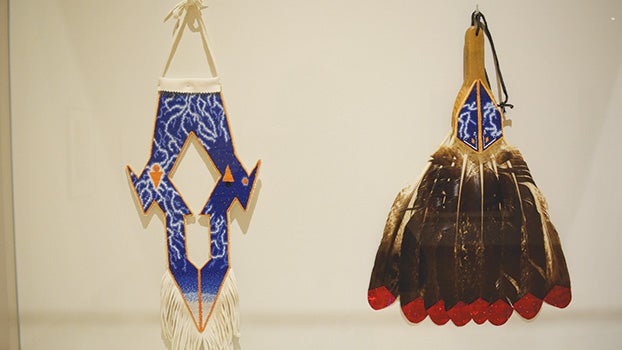Pokagon artists show off work at South Bend exhibit
Published 9:23 am Thursday, February 28, 2019

- David Martin’s dance regalia. (Leader photo/ADAM DROSCHA)
DOWAGIAC — At the Snite Museum of Art on Notre Dame University’s campus is an exhibit that focuses on the mixture of old and new, authentic and appropriated, and classic and contemporary.
Until May 18, “Revisions: Contemporary Native Art” is being featured at the O’Shaughessy Galleries I, II and III. “Revisions” is a collection of Native American artwork that highlights the history of a variety of tribes with a contemporary mark by each of the artists, some of these artist are Pokagon citizens, who are showcasing their work at the exhibit.
While the exhibit features tribal work from Mad River Band Wiyot, Mississippi Choctaw and Cherokee, Muscogee, Cheyenne, Arapaho, Salish, Kootenai, Seneca, and Navajo, three Potawatomi Pokagon Band artists are featured in the exhibit as well. David Martin, Christine Rapp-Morseau and Jason S. Wesaw have black ash baskets, healing blankets and tribal dancewear that they made by hand on display. Each have come into their own artistry by ancestral traditional, meticulous work and personal creativity.
“The pieces are meant to meant to pique people’s curiosity,” Wesaw said “It captures the attention within the work.”
Morseau comes from a line of black ash basket makers. She learned from women in her family and has kept the tradition alive. Her basket at Snite is her second museum submission. The other is on display at Epcot in Disney World. Morseau’s basket at Snite will remain in the museum’s collection.
Martin’s pieces are dance regalia that hail from traditional patterns, but portray his originality. His pieces at Snite were made when he was a teenager, he wore them and later restored them to be submitted to Snite’s collection.
Wesaw’s healing blanket was entirely hand sewn by him. Sewn on the blanket are cones with snippets of Neshnabék treaties, hung similarly to cones on regalia worn for Jingle Dress Dance for ceremonial healing. To Wesaw, his piece represents healing and reconciliation.
“It’s a healing blanket. That knowledge and healing, a person could be wrapped around in it, and it could provide knowledge wisdom and understanding, and the strengths and the pride of our people,” Wesaw said.
According to Wesaw, the Pokagon Band needs to be recognized for how it has lasted in the Michiana region as a whole. The art pieces and theme of the exhibit convey how the Potawatomi and Pokagon Band have survived and continue to adapt.
“I think it’s important reason why this exhibit is so timely and so important,” Wesaw said. “We’re still living and still vibrant. Our communities are growing and expanding.”
Wesaw also sees the exhibit as an example of how Native American artwork is not separated from the whole of modern and contemporary art. The handmade works are as representative of contemporary art as that of any other culture.
“We’re not just making shakers and tipis, but our work stands with some of the most contemporary art in the world,” he said.
The “Revisions: Contemporary Native Art” is anchored by the large-scale installation Peelatchiwaaxpáash/Medicine Crow (Raven) and the 1880 Crow Peace Delegation by Wendy Red Star (Apsáalooke (Crow)).






